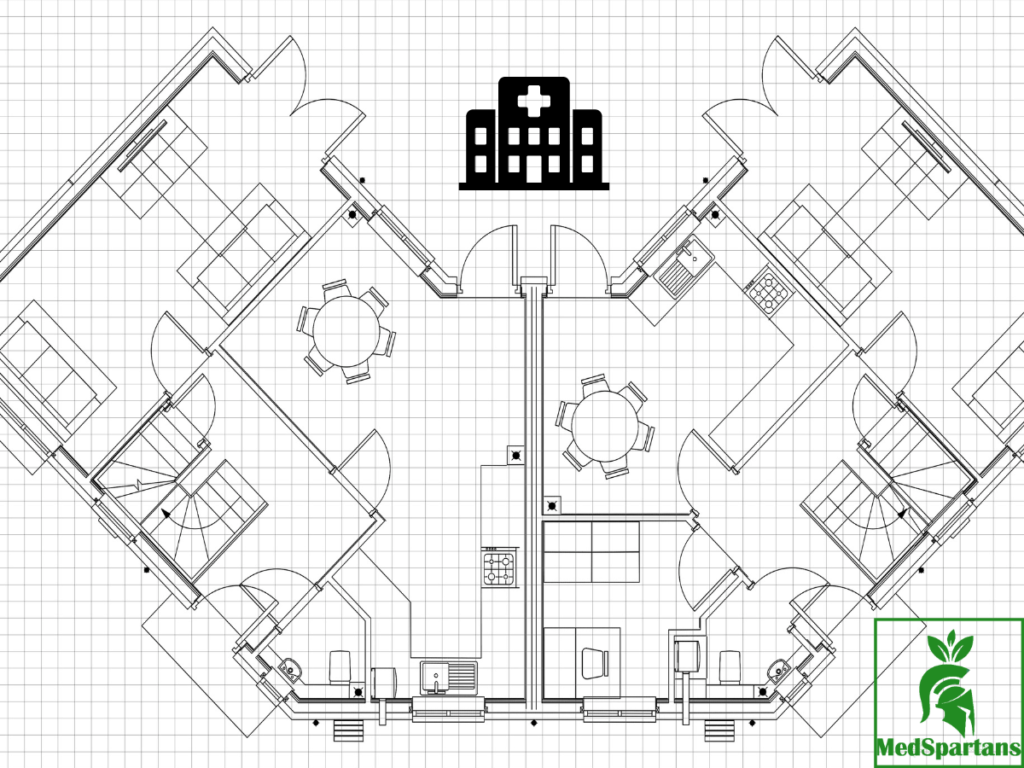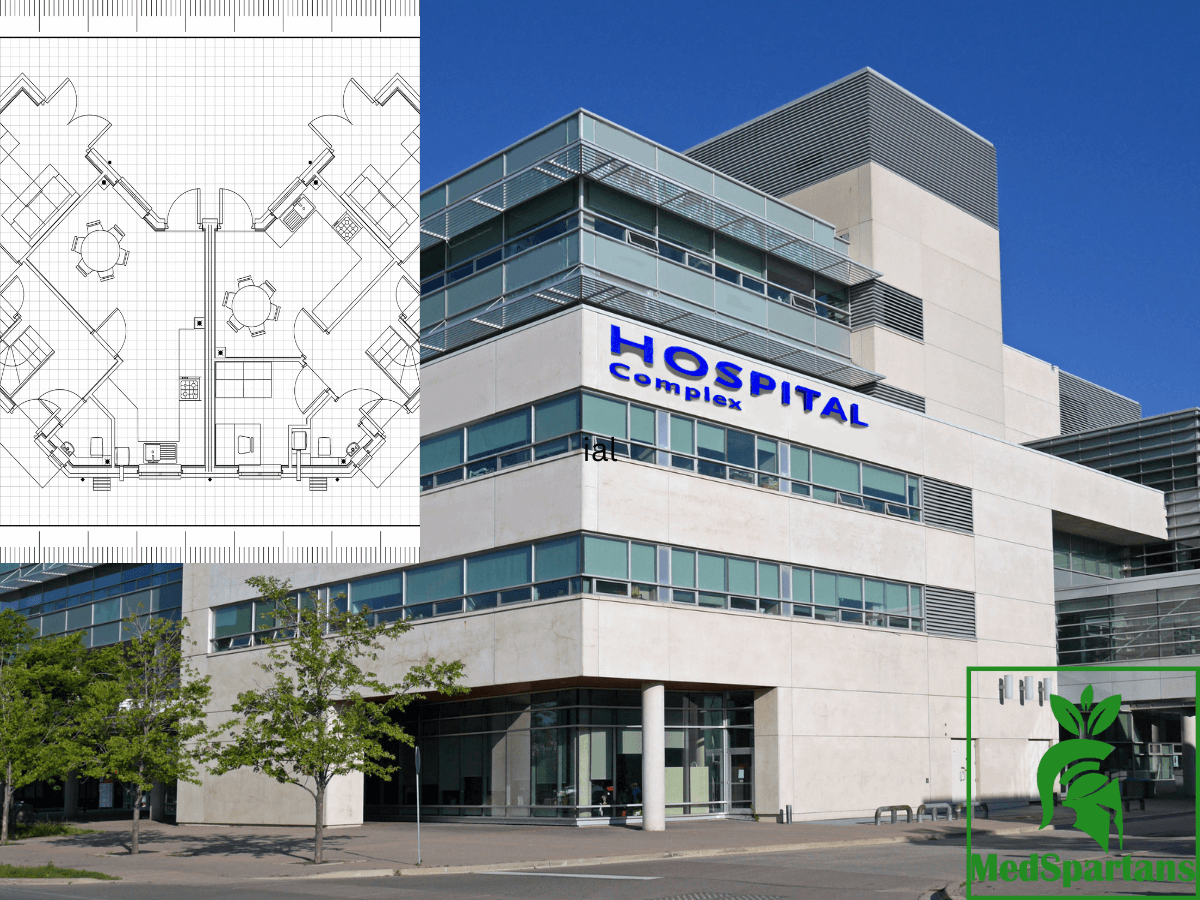Hospitals serve as pillars of our healthcare system, offering critical medical care to communities. But beyond the advanced equipment and skilled professionals lies another crucial element: design.
The design and layout of a general hospital significantly impacts patient outcomes, staff efficiency, and the overall healing environment.
This content delves into the key considerations of general hospital design, exploring how thoughtful planning optimizes functionality, fosters patient well-being, and ensures a smooth flow of care.
By examining these aspects, we can appreciate the vital role architecture plays in creating a general hospital that serves not just medical needs, but also the human experience.

Understanding User Needs: Patients, Staff, and Visitors
Understanding the diverse needs of patients, staff, and visitors is crucial in designing an effective and welcoming hospital environment. Each group interacts with the hospital in different ways, and their specific needs must be considered to ensure a positive experience.
Patients
Patients are the primary focus of any hospital, and their comfort and care are paramount.
- Comfort and Privacy: Ensure compliance with HIPAA regulations for patient privacy and dignity.
- Accessibility: Design with ADA (Americans with Disabilities Act) standards to accommodate patients with disabilities.
- Restorative Spaces: Include areas like gardens and lounges for relaxation and mental well-being, promoting holistic healing.
Staff
Hospital staff need an environment that supports their demanding and often stressful work.
- Work Efficiency: Optimize proximity between related departments to reduce travel time, enhancing workflow efficiency.
- Break Areas: Provide comfortable and private areas for staff to rest and recharge, in line with OSHA (Occupational Safety and Health Administration) guidelines for worker health and safety.
- Ergonomic Workspaces: Design workstations that minimize physical strain and maximize productivity, adhering to ergonomic standards.
Visitors
Visitors often face emotional stress and uncertainty when navigating a hospital.
- Wayfinding: Implement clear signage and easy-to-navigate layouts to help visitors find their way, ensuring compliance with ADA guidelines.
- Waiting Areas: Create welcoming, comfortable waiting areas with access to amenities like restrooms, water, and refreshments.
- Visitation Spaces: Design visitation rooms that allow for privacy and comfort during visits with patients, adhering to patient and family-centered care principles.
Optimizing Functionality: Departmental Layouts and Flow For General Hospital
The functional design of a hospital is fundamental to its efficiency. Thoughtful layouts and flow ensure that medical professionals can deliver care promptly and effectively.
Emergency Department (ED)
The Emergency Department needs to be easily accessible and highly efficient. We have covered a detailed Emergency Department and Room Design right “here”. Do check it out!
- Proximity to Entrance: Locate the ED near the main entrance for quick access.
- Clear Pathways: Ensure clear, unobstructed paths for patient transport, complying with NFPA (National Fire Protection Association) codes.
- Separate Areas: Designate separate areas for triage, treatment, and observation, following ACEP (American College of Emergency Physicians) guidelines.
Surgery Department
Surgical areas require meticulous design to ensure sterility and efficiency.
- Sterile Corridors: Implement sterile corridors to minimize infection risk, adhering to AORN (Association of periOperative Registered Nurses) standards.
- Proximity to ICU: Place the surgery department near the Intensive Care Unit for quick post-operative care.
- Flexible Operating Rooms: Design operating rooms that can accommodate various types of surgeries, following AIA (American Institute of Architects) guidelines for healthcare facilities.
Inpatient Units/Wards
Inpatient units or wards should prioritize patient care and monitoring.
- Central Nursing Stations: Position nursing stations centrally for efficient patient monitoring.
- Patient Room Layouts: Arrange patient rooms to maximize natural light and views of nature, promoting better patient outcomes as supported by evidence-based design.
- Family Areas: Include spaces for family members to stay overnight if needed, supporting family-centered care principles.
Facilities Needed In A General Hospital Design & Layout
The size and scale of a hospital significantly influence the facilities needed to provide comprehensive care. Here’s a breakdown of the facilities typically required for small, medium, and large general hospitals:
Small General Hospital Layout
Here are all the minimal requirement for a small general hospital. However, they can be changed depending on the services the hospital expertises. Here are the specs for a small general hospital:
Room Count
- Total Rooms: Approximately 20-50 rooms
Area
- Total Area: Approximately 5,000 – 20,000 square feet (465 – 1,860 square meters)
Bed Count
- Total Beds: Approximately 10-50 beds
Core Facilities
- Emergency Department (ED):
- Triage area
- Basic emergency treatment rooms
- Ambulance bay
- Inpatient Units:
- Patient rooms (private or semi-private)
Diagnostic and Treatment Facilities
- Laboratory:
- Basic lab for blood tests and other routine diagnostics
- Imaging:
- X-ray
- Ultrasound
- Pharmacy:
- Dispensing medications
- Storage for essential drugs
Support Services
- Administration:
- Reception area
- Billing and records
- Cafeteria:
- Small dining area for patients, staff, and visitors
- Housekeeping and Laundry:
- Basic cleaning and laundry services
Auxiliary Services
- Physical Therapy:
- Small rehab area with basic equipment
- Health Education:
- Rooms for health education and community outreach
Note: A small general hospital typically features 20-50 rooms within 5,000-20,000 square feet, accommodating 10-50 beds. Core facilities include a basic emergency department, inpatient units, lab, X-ray, ultrasound, pharmacy, administration, cafeteria, housekeeping, physical therapy, and health education. These minimal requirements ensure essential care and services, adaptable to the hospital’s specialized needs.
Medium General Hospital Design & Layout
A Medium General Hospital is about twice the size of a small sized one. Here are the design specs of a medium general hospital:
Room Count
- Total Rooms: Approximately 100-200 rooms
Area
- Total Area: Approximately 50,000 – 100,000 square feet (4,650 – 9,300 square meters)
Bed Count
- Total Beds: Approximately 50-200 beds
Core Facilities
- Emergency Department (ED):
- Triage area
- Multiple emergency treatment rooms
- Ambulance bay
- Inpatient Units:
- Patient rooms (private, semi-private, and wards)
- Nursing stations
- Intensive Care Unit (ICU)
Diagnostic and Treatment Facilities
- Laboratory:
- Comprehensive lab services for a wide range of tests
- Imaging:
- X-ray
- Ultrasound
- CT scan
- Pharmacy:
- Comprehensive drug dispensing
- Drug storage and inventory management
- Operating Theatres:
- Operating rooms for various surgical procedures
- Maternity Ward:
- Labor and delivery rooms
- Neonatal care
Support Services
- Administration:
- Reception area
- Billing and medical records department
- Administrative offices
- Cafeteria:
- Dining area for patients, staff, and visitors
- Housekeeping and Laundry:
- Comprehensive cleaning and laundry services
Auxiliary Services
- Physical Therapy:
- Well-equipped rehab area with diverse equipment
- Health Education:
- Rooms for health education and community outreach
- Counseling Services:
- Rooms for psychological and social counseling
Note: A medium general hospital, spanning approximately 50,000 – 100,000 square feet and housing 100-200 rooms with 50-200 beds, includes essential facilities such as multiple ED treatment rooms, ICU, comprehensive lab and imaging services, operating theatres, and a maternity ward. It also provides support services like administration, dining, housekeeping, and auxiliary services including physical therapy, health education, and counseling.
Large General Hospital Layout & Design
Large Gereral Hospitals are often built by governments. Private sectors rarely get into larger general hospitals. But for the sake of knowing stuff, here are the specification of large general hospitals:
Room Count
- Total Rooms: Approximately 300-500+ rooms
Area
- Total Area: Approximately 100,000 – 500,000+ square feet (9,300 – 46,500+ square meters)
Bed Count
- Total Beds: Approximately 200-1000+ beds
Core Facilities
- Emergency Department (ED):
- Triage area
- Multiple emergency treatment rooms
- Trauma center
- Ambulance bay
- Inpatient Units:
- Patient rooms (private, semi-private, and wards)
- Multiple nursing stations
- Intensive Care Unit (ICU)
- High Dependency Unit (HDU)
Diagnostic and Treatment Facilities
- Laboratory:
- Comprehensive lab services for a wide range of tests
- Specialized labs (e.g., pathology, microbiology)
- Imaging:
- X-ray
- Ultrasound
- CT scan
- MRI
- Pharmacy:
- Comprehensive drug dispensing
- Drug storage and inventory management
- Compounding pharmacy
- Operating Theatres:
- Multiple operating rooms for various surgical procedures
- Maternity Ward:
- Labor and delivery rooms
- Neonatal Intensive Care Unit (NICU)
Support Services
- Administration:
- Reception area
- Billing and medical records department
- Administrative offices
- Conference rooms
- Cafeteria:
- Large dining area for patients, staff, and visitors
- Staff-only dining area
- Housekeeping and Laundry:
- Comprehensive cleaning and laundry services
- Sterilization unit
Auxiliary Services
- Physical Therapy:
- Well-equipped rehab area with diverse equipment
- Hydrotherapy pool
- Health Education:
- Rooms for health education and community outreach
- Counseling Services:
- Rooms for psychological and social counseling
- Mortuary:
- Facility for handling deceased patients
- Research and Teaching:
- Research laboratories
- Lecture halls and classrooms
- Specialty Clinics:
- Cardiology
- Oncology
- Neurology
- Dermatology
Note: A large general hospital spans approximately 100,000 to 500,000+ square feet, housing 300-500+ rooms and 200-1000+ beds. Key facilities include an extensive ED with a trauma center, comprehensive inpatient units, diverse diagnostic and treatment facilities (labs, imaging, pharmacy), multiple operating theatres, and robust support and auxiliary services like physical therapy, health education, counseling, and research labs.
If you want a more customized support for your healthcare design, we will help you out.
Creating a Healing Environment: Light, Space, and Ambience
A healing environment is more than just a pleasant space; it actively contributes to patient recovery. Thoughtful use of light, space, and ambience can make a significant difference.
Natural Light
Natural light has a profound impact on well-being and recovery.
- Large Windows: Use large windows to maximize natural light in patient rooms and common areas.
- Skylights: Incorporate skylights in corridors and waiting areas.
- Light Wells: Utilize light wells to bring daylight into the building’s core, adhering to energy efficiency standards like LEED (Leadership in Energy and Environmental Design).
Space
The perception of space affects both physical and mental health.
- Open Layouts: Design open and spacious layouts to reduce feelings of confinement.
- High Ceilings: Incorporate high ceilings to enhance the sense of space.
- Quiet Zones: Create quiet zones away from high-traffic areas to promote rest, following guidelines from the Center for Health Design.
Ambience
The right ambience can soothe patients and reduce stress.
- Color Schemes: Use calming and soothing color schemes throughout the hospital.
- Art and Décor: Integrate artwork and décor that reflects the local culture and nature, following evidence-based design principles.
- Acoustic Design: Employ sound-absorbing materials to minimize noise levels, in line with FGI (Facility Guidelines Institute) standards.
General Hospital Safety and Efficiency (Infection Control and Technology Integration)
Safety and efficiency are the cornerstones of effective hospital design. Incorporating the latest in infection control and technology ensures a safe and efficient environment.
Infection Control
Preventing infections is a top priority in hospital designs and layouts.
- Isolation Rooms: Design isolation rooms with negative air pressure to contain infections, complying with CDC (Centers for Disease Control and Prevention) guidelines.
- Hand Hygiene Stations: Install hand hygiene stations at strategic locations, following WHO (World Health Organization) recommendations.
- Easy-to-Clean Surfaces: Use materials that are easy to clean and disinfect, adhering to EPA (Environmental Protection Agency) standards.
Technology Integration
Integrating technology enhances patient care and operational efficiency.
- Electronic Health Records (EHR): Ensure seamless integration of EHR systems, following HIPAA regulations for data security.
- Telemedicine Facilities: Include spaces equipped for telemedicine consultations, supporting remote care standards.
- Smart Systems: Implement smart systems for lighting, temperature control, and patient monitoring, complying with UL (Underwriters Laboratories) standards.
Sustainable Design: Eco-friendly Practices and Resource Management
Sustainability in hospital design is not just about reducing environmental impact; it’s about creating healthier environments for everyone involved. (Reguardless shapes you use for the hospital design, example H-shape, or L-shape, the Safety standards will be the same.)
Eco-friendly Practices
Eco-friendly practices help reduce the hospital’s environmental footprint.
- Green Roofs: Use green roofs to improve insulation and reduce the urban heat island effect.
- Solar Panels: Install solar panels to generate renewable energy, supporting sustainability certifications like LEED.
- Water Conservation: Implement rainwater harvesting and low-flow fixtures, complying with EPA guidelines.
Resource Management
Efficient resource management is crucial for sustainability.
- Energy-efficient Systems: Use energy-efficient HVAC Systems and lighting systems.
- Waste Management: Implement comprehensive waste management and recycling programs, adhering to local and state regulations.
- Sustainable Materials: Choose building materials with low environmental impact and high durability (concrete, steel, glass), supporting green building standards.
The Future of General Hospital Design: Adaptability and Innovation
Other than the structural engineering, the future of hospital design lies in adaptability and innovation. As medical technology and patient needs evolve, so too must the environments in which care is provided.
Adaptability
Adaptable designs ensure hospitals can meet changing demands.
- Modular Design: Use modular construction to allow for future expansions and reconfigurations.
- Flexible Spaces: Design spaces that can be easily adapted for different uses.
- Technology Upgrades: Plan for easy integration of future technological advancements, adhering to guidelines from the Health Information and Management Systems Society (HIMSS).
Innovation
Innovative designs can revolutionize patient care and hospital operations.
- Smart Hospitals: Develop smart hospital systems with interconnected devices and data analytics.
- Biophilic Design: Incorporate biophilic design principles to connect patients and staff with nature.
- Patient-centered Care: Focus on designs that enhance the patient experience and outcomes, in line with Planetree International principles.
Conclusion
Designing a general hospital requires careful consideration of the needs of patients, staff, and visitors while balancing functionality, safety, and sustainability. By integrating modern technology and anticipating future innovations, hospital design can create environments that promote healing, efficiency, and adaptability. The ultimate goal is to provide a space that not only supports medical care but also enhances the overall experience for everyone who walks through its doors.



